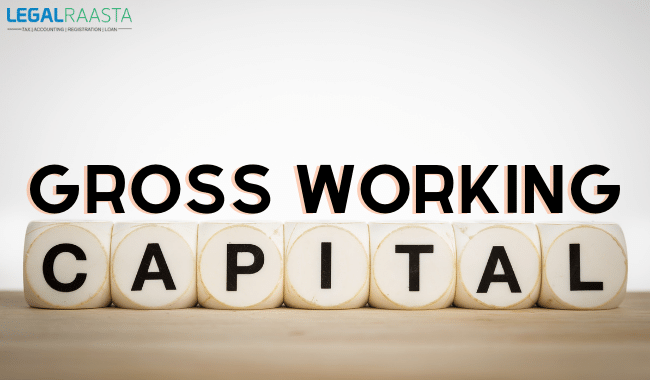Gross working capital is a valuable metric for determining a company’s accessible cash flow inside an organization. As a result, it plays an important role in accounting procedures, assisting both firm owners and financial analysts in making important financial decisions. To guarantee total profitability, however, business owners must implement strategies to effectively manage gross working capital.
Gross working capital is an important measure of a company’s liquidity and financial strength. It shows how easily the company can pay off its short-term liabilities, such as bank overdrafts, debentures, and trade creditors. It also reflects the value of inventories held by the company and is therefore taken into account when arriving at the market value of a company for takeover purposes etc. The most commonly used ratio to calculate GWC is the current ratio.
What is Gross Working Capital?
Contents
- Gross working capital refers to a company’s overall current asset amount at any particular moment within an accounting year.
- It includes any assets that can be converted into cash quickly within an accounting period.
Cash, inventory, accounts receivable, marketable securities, commercial paper, and short-term investments are common examples.
- In other words, it’s the amount of money a company has on hand to meet its current asset-related needs.
- A company’s gross working capital will always be negative in any given condition. Working capital does not, however, provide a complete picture of a company’s liquidity.
- This is due to the fact that a company’s liabilities are not factored into the calculation of this sort of working capital.
- Borrowing funds, for example, may improve a company’s gross working capital, but it will also increase the company’s current liabilities. As a result, the forecasted financial picture is erroneous or incomplete.
As a result, gross working capital does not add considerable value to a company’s assets. When it comes to maintaining day-to-day operations afloat, though, it is critical.
Many factors affect working capital; some specific to each balance sheet item; others which apply to the overall firm. They include changes in prices, changes in receivables and payables volumes, time lags between the purchase of raw materials and the sale of finished goods. All these factors affect liquidity as well as profitability.
- GWC is defined simply as the sum total of all the current assets of a company and any calculations involving GWC can be complex and confusing.
- All current assets are treated as liquid assets and it includes cash, bank balances, short term investments, accounts receivables, etc. Current assets are further classified into different subcategories depending on their life cycles.
Cash: Cash is the most liquid asset and it represents only 5% – 10% of the total current assets. Cash includes currency notes, bank balances, and bankers drafts.
Bank Balances: Bank balance represents money that is kept in an account at a bank for transaction purposes. It is more liquid than investments but less liquid than cash. It includes all savings accounts, fixed deposits etc., with about 40% – 50% of the entire current assets.
Short-term Investments: Short-term investments are those that can be liquidated within a year or within a period not exceeding 18 months. They include treasury bills, call money etc., which makes up 25% – 35% of the total current assets.
Accounts Receivable: This component does not involve any cash inflow now as it relates to a credit sale. It involves money that is expected to come in the near future and it is about 35% – 45% of total current assets.
Inventory: Inventory refers to finished goods that are yet to be sold or raw materials that have been purchased as they will turn into revenue-generating items as soon as possible. They do not constitute any cash inflow at present but they involve 40% – 50% of all current assets.
An increase in any one of these components leads to an increase in capital employed, which means less working capital available for other organizations, holding companies, etc., resulting in a higher cost of borrowing and more expensive loans/financing. For example, an increase in inventory would mean more investment in the purchase of stock, which would increase accounts payable and decrease cash, which could lead to a higher borrowing cost depending on the type of financing used.
Calculation of Gross Working Capital
The calculation for gross working capital used by business owners and financial analysts is –
Gross Working Capital = Total Value of Current Assets
Or,
Receivables + Cash and Marketable Securities + Inventory + Short Term Investments + Other Current Assets = Gross Working Capital
It’s worth noting that removing current liabilities from current assets yields working capital or a company’s networking capital.
If the resulting working capital is positive, this means the company’s current assets exceed its current liabilities.
Following that, business owners must determine the company’s working capital ratio in order to assess its financial health. – is the ratio’s formula.
Current Assets / Current Liabilities = Working Capital Ratio
A ratio of less than one implies that the corporation may have difficulty repaying its short-term debt.
An excess of working capital, on the other hand, may not be helpful to the organization and should be directed elsewhere to reap the benefits. To put it another way, a company’s management must assure proper working capital management in order to meet its objectives.
Gross Working Capital’s Importance
The relevance of gross working capital is emphasized in these pointers.
- A detailed examination of gross working capital in comparison to current liabilities provides a reasonable estimate of a company’s current liabilities.
- Determining a company’s gross working capital provides insight into the expected cash flow accessible to business owners.
- It aids in determining a company’s financial standing and ability to repay debts in a timely manner.
- It aids in the calculation of the working capital ratio, which is used to determine a company’s ability to pay off debts on time.
- Gross working capital allows investors and shareholders to make well-informed investment decisions.
- Using gross working capital, business entities and financial analysts can calculate a company’s networking capital. In every given situation, a firm’s net working capital is thought to be more capable of assessing the firm’s liquidity.
- The problem of gross working capital, as previously stated, stems from the fact that it is ineffective as a financial statistic. If you use it to evaluate a company’s financial performance or profitability, you’ll get half-baked results.
Difference between Gross Working Capital and Net Working Capital
| Parameters | Gross Working Capital | Net Working Capital |
| Definition | A company’s gross working capital is the total of all current assets. | The difference between a company’s current assets and current liabilities is referred to as networking capital. |
| Concept | Gross Working capital is a quantitative concept | Net Working Capital is a qualitative concept. |
| Indicator | It shows how much money is available to fund current assets and other obligations.
|
It shows a company’s ability to pay off operating costs and existing liabilities without difficulty. |
| Increase in value | With an increase in borrowing, the value of gross working capital rises. | -An increase in debt will not raise a company’s working capital. Only an increase in retained income and the sale of fixed assets can raise it. |
| Formula | Receivables + Cash and Marketable Securities + Inventory + Short Term Investments + Other Current Assets = Gross Working Capital
|
Total current assets minus total current liabilities equals net working capital. |
| Suitability | It is appropriate for businesses. | It is appropriate for sole traders and partnership firms. |
| Usage | Gross working capital, along with other financial measures, is used to assess a company’s financial health. | Networking capital is a useful financial metric for estimating a company’s financial position. |
| Popularity | In financial management, the notion is well-known. | In the accounting system, the concept is quite prevalent. |
Conclusion
To get the most out of gross working capital, companies must consider both its advantages and disadvantages. It will assist them in managing and optimizing the firm’s current assets. To project a more accurate financial image, they should also employ effective strategies and use dependable financial measures such as the working capital ratio, among others.
The working capital requirement depends on the size and type of industry that a firm is in. It also varies significantly across countries because of variations in interest rates, inflation rates, cost structure, etc. Larger companies have higher working capital requirements than smaller ones because they manage multiple inventory cycles throughout the year. For example, retail companies keep larger inventories while service-oriented companies need less working capital.
Smaller businesses though may not have enough capital for significant inventory levels. This could be a major constraint in their growth.
Working capital requirements are high in developing countries due to low credit availability, underdeveloped financial markets, and weaker currencies. However, these factors have started to change over the last decade or so because of economic liberalization efforts.
For example, working capital requirements have been declining in India over the last few years because of the growing organized retail presence, government initiatives like Make in India, Digital India, etc. Also, better access to credit has made managing working capital easier for companies because they can meet liabilities during downturns without having to resort to distressed sales of assets.
Related Posts:






